In 1959, the Nobel Laureate in physics, Richard Feynman, gave a speech entitled "there is plenty of room at the bottom" at the California Institute of technology, first envisioning the possibility of micro robots in the body.
In Feynman's conjecture, this kind of micro robot is driven by micro electro mechanical system (MEMS) and can enter the body to perform surgery. At that time, Feynman said, "if we can swallow a surgeon, many complex operations can become very interesting and simple."
Perhaps Feynman's influence was too great. Ten years later, before the scientific research community carried out research, American director Richard Fleischer made Feynman's idea into a classic sci-fi film, fantastic voyage. In the film, five doctors were reduced to a few million times their original volume and injected into a patient whose brain blood vessels were damaged and whose life was at stake. After a series of adventures, they finally succeeded in finding the bleeding point and saving the patient's life in time.
But is it only an illusion that a micro robot can enter a human body? The answer is clearly doubtful.
Since the concept of "in vivo surgeon" was put forward by henchman, scientists have been attracted and motivated by this idea, invested in the research of micro robots, and achieved many good results. Scientists imagine that in the future, machines can really enter people's bodies to achieve targeted therapy, targeted drug delivery, and help treat major diseases such as tumors.
1. "Slim" robot
Some time ago, a magnetic controlled slime micro robot called "slim" became popular with new scientist.
It is made of magnetic mucus material. It can enter the body and take out small devices swallowed accidentally. As soon as it was released on April 1, it immediately caused a great sensation in the science and technology community. Netizens were shocked, and the browsing click through rate quickly exceeded 100000, millions and millions:
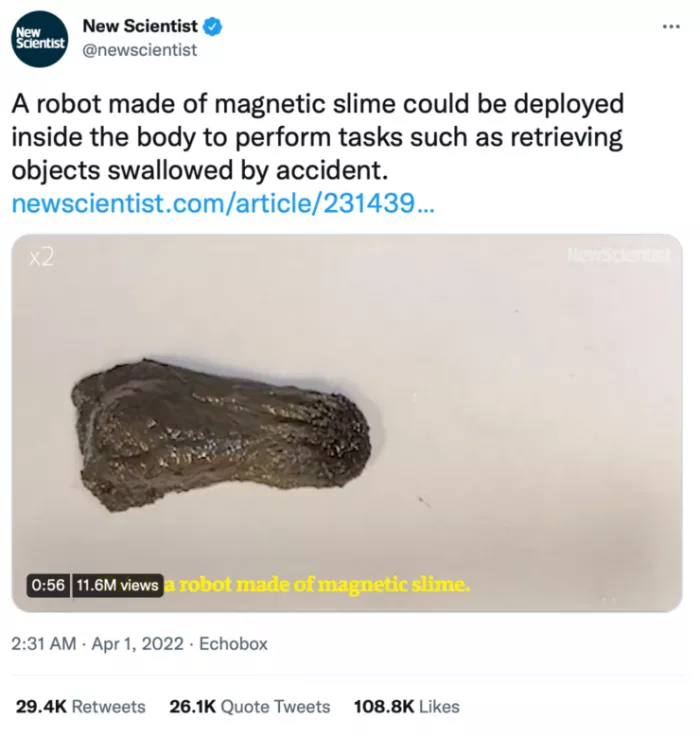
Different from our common robots, this robot is more like a "monster" in terms of shape, action and ability, which is quite different from the "machine" and "human" that we imagine are made of rigid hardware and whose five senses and body are similar to human beings.
According to the demo, it looks like a lump of dark dough, with no head, face, hands or feet, a soft body and various shape changes.
However, despite its poor appearance, the "slim" robot has a variety of unique functions. It can change its soft body, go through narrow gaps, repair broken wires, and take out electronic components swallowed in the digestive tract of the human body.
Even if it is cut into several sections and then reassembled, it still has the ability of "self-healing".
"Slim" robot has broken the traditional impression of "robot" by most people. It has also brought "in vivo micro robot" into the public's view with its cool sense of future and potential powerful power.
Professor Zhang Li of the Chinese University of Hong Kong, one of the R & D members of the shrem robot, introduced that the "self-healing" ability is also one of the hot research directions in the field of software robots, which is mainly reflected in its high adaptability to different environments. The strength of the "shrem" robot is not only that it can heal itself after cutting it off, but also that it can maintain its complete shape when put into liquid, and can travel unimpeded even in air and solid environment.

Photo note: Zhang Li, Professor, Department of mechanical and automation engineering, Chinese University of Hong Kong
In fact, in recent years, the research results of micro robots emerge in endlessly, such as the flying robot driven by micro motors and the size of flies / beetles. Unlike them, the "slim" robot is unique in that it adds magnetic powder and magnetic particles to non-Newtonian liquid materials, so as to realize magnetic field control and make it sensitive and even free to deform.
The "self-healing" ability of the "slim" robot also relies on the characteristics of the material itself and the magnetic guidance of the outside world. After the "body" is cut off, it is interacted and re integrated by the polymers close to each other.
It should be noted that the "slim" robot currently has no ability to move autonomously. Its movement and expansion depend on the neodymium magnet (which can be understood as "powerful small magnetic ball") controlled by the external magnetic field.
"The shrem robot itself has no fixed shape. It is mucilaginous. After adding a magnetic field, it will respond to the magnetic field. If you move the magnet from left to right, it will follow the magnet from left to right. It is easy to change its shape due to the size of the magnetic force. For example, if someone accidentally swallows harmful components, it will become a hand and grab packages." Zhang Li introduced AI technology review.
This is also the first time that the advanced nanomaterials & Robotics Laboratory (anml) led by Zhang Li has made a magnetic mucus robot. Previously, anml has made many different types of micro nano robots, including bionic insect robots printed with 3D technology, which are operated remotely based on magnetic fields. "However, it is the first time that slimy robots such as the" slim "robot can roll up like an elephant's nose." Zhang Li said.
What is more amazing is that it took only half a year for sun Mengmeng, the first author of this work and an on-the-job Postdoctoral Fellow of anml laboratory, to join anml, start research and development and publish articles.

Note: Dr. Sun Mengmeng
"This is mainly because sun Mengmeng had some ideas when he was a doctoral student at Harbin Institute of Technology (under the guidance of Professor Xiehui). After coming here, with the help of a lot of experience accumulated by our research group in related materials and magnetic control operation, the project went smoothly." Zhang Li introduced.
Considering the complexity of the internal environment of the human body, Zhang Li's team imagined that the "shrem" robot might have a certain application space in the digestive tract. The main reasons are as follows: first, the cavity of the digestive tract is large, and the shuttle of the "shrem" robot will be relatively smooth; Second, there are many microbial flora in the digestive tract of human body, so the risk of trying the robot in vivo is relatively low; Thirdly, the materials used to make the "shrem" robot have passed the cytotoxicity test, and the toxicity is low. If they only stay in the body for a short time and then leave the body, they are theoretically safe.
Of course, at present, the idea of using the "slim" robot as an in vivo treatment actuator is still in a tentative stage and needs to be further explored.
2. Development of micro robot in vivo
The performance of the "slim" robot is gratifying, but the development history of this micro robot that can enter the body is only a few decades.
In the 1970s, US intelligence agencies tried to design some micro robots that could perform POW assistance and electronic interception missions in order to promote confidential research. However, since the underlying support technology was not fully developed at that time, the prototype of the micro robot was not developed from this set of early calculations and concepts.
Until the 21st century, micro machines were officially introduced. With the development of MEMS, micro actuator and other multi-disciplinary fields, micro robot has made important technological breakthroughs and gradually become an international research hotspot.

Note: bionic micro robot
Compared with the large-scale robots that have studied for more than half a century, the development of micro robots has only been more than 20 years, and "micro robots that can enter the body" are even fewer, both at home and abroad are in the initial stage.
There are different types of micro robots. Among them, micro medical robots are considered as the most promising application field in the industry. The Japanese Academy of science and technology policy has predicted that "in the future, the use of micro robots and robotic surgery in the medical field will exceed half of all medical operations".
In foreign countries, Japan takes the lead in adopting the "robot surgeon" plan, and is developing a subminiature robot that can travel through human blood vessels and be used to find and kill cancer cells. Johnhopkin laboratory in Maryland, USA, has developed a micro detection device equipped with a micro silicon thermometer and a micro circuit, which can be swallowed into the body and send the temperature information to the recorder. Swedish scientists have invented a robot the size of English punctuation marks. In the future, it can move a single cell or catch bacteria, and then perform various operations in the human body.
Domestic researchers also paid early attention to this cutting-edge direction, such as professor sunlining of Suzhou University and Professor liulianqing of Shenyang Institute of automation. Young scholars such as Zhang Li, a professor at the Chinese University of Hong Kong, and Xu Tiantian, a researcher at the Shenzhen Institute of advanced technology, are also unwilling to fall behind. They start from the two directions of materials and control to explore new opportunities.
In general, the realization of in vivo robot has three major elements: first, the realization of "micro" shape; The second is the safety materials suitable for the internal environment; The third is the "autopilot" technology of the robot in the body.
Take the "shrem" robot for example, its biggest breakthrough is materials. It adopts polyvinyl alcohol and borax materials with non-Newtonian fluid characteristics, plus a layer of silicon dioxide. Its viscosity changes with the contact with the outside world. It has high adaptability to the environment. It can extend and crawl in the gaseous, liquid and solid environment, and can carry out multi-modal manipulation.
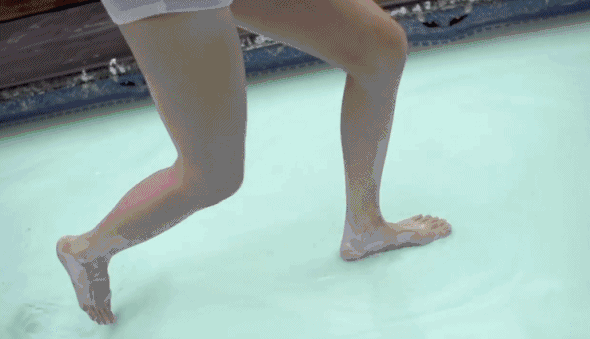
Photo note: non Newtonian liquid can be poured into the tank for water floating
However, the toxicity safety of borax has not been guaranteed. One of the current research priorities in this field is to find materials more suitable for building micro medical robots. The material shall be flexible, skin friendly, non-toxic and harmless, easy to remove from the body, easy to operate, etc.
As for innovation and safety, Professor Zhang Li's view is: "sometimes scientists and doctors have different ideas. Doctors tend to be conservative and tend to consider safety first, while scientists emphasize innovation more. There is a certain contradiction between the two." But in the medical scene, there is no doubt that safety must be the first.
In addition to materials, the path control of micro robot in vivo is another difficult problem to be solved to realize "surgeon". In recent years, the research focus of in vivo micro robot has experienced three stages: from open-loop control to closed-loop control, from single motion mode to multiple motion modes, and from single robot to multiple robots. The control of micro robot clusters has practical application value in the in vivo medical scene, and it is also a major research trend in the robot field.
Compared with a single robot, the cluster micro robot has two advantages:
First, reduce the failure rate. For example, for drug loading, the drug loading dose of the cluster robot can be increased. In addition, in blood and other environments, a single micro robot is easy to be washed away by blood or swallowed by macrophages. At this time, if you switch to a cluster robot, you can improve the success rate of treatment;
Second, the cluster is convenient for observation. Today's robots can achieve nanometer scale, but when they are placed in the body, it is very difficult to clearly observe a single robot with the existing medical imaging equipment. Just like diving, we tend to overlook a small fish swimming in front of us, but we are often shocked by a group of dark fish in the distance.
3. Path control: internal "driving"
In terms of path control of micro robots, xutiantian, a researcher of Shenzhen Institute of advanced technology, Chinese Academy of Sciences (hereinafter referred to as "Shenzhen Institute of advanced technology"), is a scientific research "new star".
Xutiantian was born in automation control background. He obtained his master's degree and doctor's degree from the central Polytechnic University of Paris and the sixth University of Paris. He began to study micro robots during his doctor's period. After her doctoral degree in 2014, she joined the team of Professor Zhang Li of the Chinese University of Hong Kong as a postdoctoral researcher. In 2016, she officially joined the intelligent bionics center of the integration Institute of Shenzhen Advanced Research Institute. At present, she is the only scientist in Shenzhen Advanced Research Institute who studies the path control of medical micro robots.
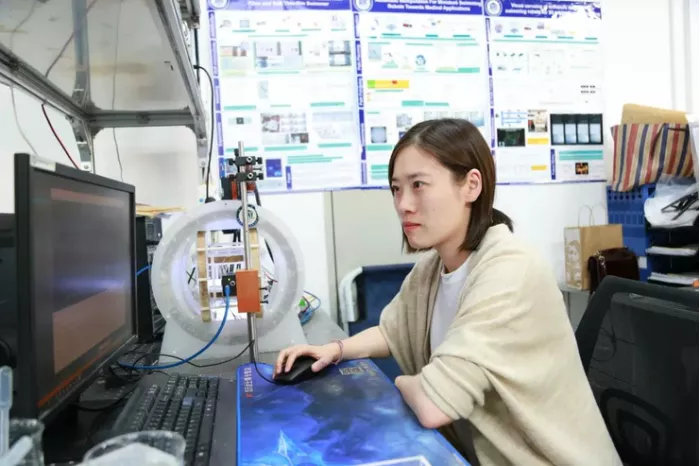
Photo note: xutiantian, researcher of Shenzhen Institute of advanced technology
From the perspective of Professor xutiantian, the research on path control of micro robot in vivo can be divided into three directions: first, how to make the micro robot move in vivo? Second, how to make them move according to the established path? Third, how to adapt them to the complex environment in the body?
If the micro robot is compared to a car, the robot's Suspended Movement in the body is equivalent to controlling a car to drive in the air of a complex downtown, which is extremely difficult and has extremely high safety risk factors.
It should be noted that many physical laws in the micro world are different from those in the macro world. For example, in 1976, Nobel physicist e.m.purcell put forward the "scallop theory", that is, when the scallop rapidly opens and then slowly closes the shell, due to inertia, the scallop will move forward when it rapidly opens, forming a "moving forward" step by step. However, in the micro world, the inertia force is almost negligible in the face of viscosity, and the opening and closing action of scallops can not make it move forward.

The internal environment of human body is also a microcosm. How to make the micro robot move in the body?
Xutiantian cooperates with his team to draw inspiration from nature: one is E. coli, which is driven by a spiral tail, just like screwing a screw, turning and moving forward at the same time; The other is the sperm's flexible vibration, which moves forward by flapping its tail. In these two ways, they have successfully manufactured spiral robots and sperm like bionic robots, and successfully made the robots move in the simulated environment.

Note: the micro robot "spirals" forward in the liquid
However, it is not enough to let the robot move in the body. It is necessary to ensure that the path ahead is safe, and that you can't run amuck in your body
Therefore, in order to ensure the "accurate" shuttle of the robot in the body, bypass the dangerous area and ensure safety, it is particularly important to study the path control of the micro robot. As mentioned above, the robot runs "in the air", which requires the robot to have 3D movement ability.
In 2019, Xu Tiantian's team proposed a new path following control algorithm, which uses the path differentiation method to differentiate any given path into segments, and let it find its nearest segment at each point to control its direction. Their algorithm has successfully realized 3D path control for millimeter level magnetically driven software robots, and their related work has won the best application paper award of IEEE International Conference on intelligent robots and systems (iros):
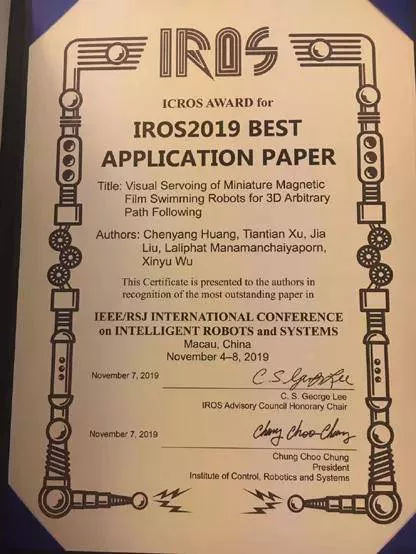
In the area of path control, xutiantian's team also adopts magnetic control. The main advantage of magnetic control is that it can be operated wirelessly: if the robot enters the body, human researchers or doctors can operate it outside the body. At the same time, the response time of magnetic control is short, the power density is high, and the repeatability is also high. The robot can successfully reach the lesion for many times, eliminating the randomness of the success rate.

Note: multi degree of freedom magnetic control device of xutiantian team
After realizing the 3D path control of a single robot, xutiantian and his team moved forward to the research of multi robot cooperative control.
Xutiantian explained to AI science and technology review that there are two difficulties in the crowd operation of microcomputer based on magnetic control: one is that the input signals in the same magnetic field are the same, which will lead to the consistent forward direction and speed of multiple micro robots; Second, there is a lack of communication between micro robots, which can not be controlled independently.
In order to solve this problem, xutiantian studied with his team for many years and finally achieved results at the beginning of this year——
They put forward a completely decoupled method, which does not require communication, uses external unified signals to sense the robot, and solves the problem of how to generate different outputs for the same signal. For the first time, they realized the independent position control of four magnetic software micro robots and the independent path following control of three magnetic software micro robots, Relevant work ("independent control strategy of multiple magnetic flexible robots for position control and path following") was published on the top issue of international robotics t-ro.
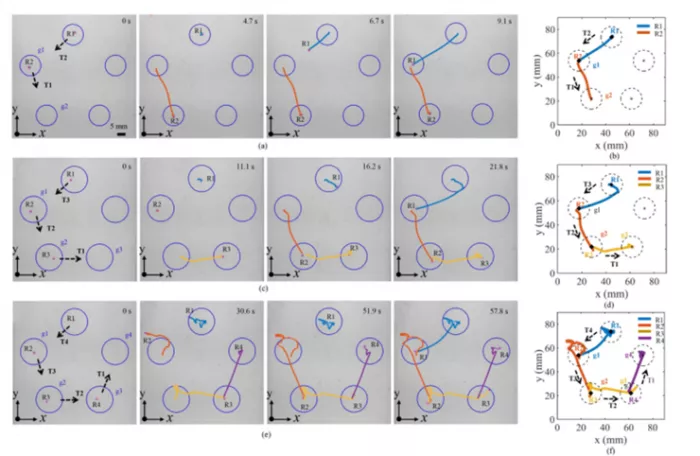
Note: independent position control of millimeter robot: (a) position control of two robots; (c) Position control of three robots; (e) Four robot position control; (b) , (d) and (f) are the corresponding position trajectories of the robot
This work is a great step forward in the cooperative control of multi micro robots. However, xutiantian also told AI science and technology review that at present, they have only realized the independent control of four micro robots. In the future, they will move towards greater goals.
It is worth noting that the introduction of artificial intelligence algorithms in path control is also becoming a trend. For example, xutiantian and others have adopted the "width learning" method proposed by chenjunlong, Dean of the school of computer science, South China University of technology, in 2016 to automatically calculate and optimize the control rate of robots in complex environments, so as to achieve better control.
4. Imagination and reality
So, how long before the micro robot enters the body?
There is no doubt that Feynman's conjecture is very avantgarde, and the idea of "internal surgeon" is also fascinating.
Some time ago, nature also published a paper discussing the prospect of micro robots for cancer treatment. For example, anti-cancer drugs usually use shotgun method. The traditional treatment method is intravenous injection of blood clotting drugs, but it will face the risk of thrombosis. While chemotherapy destroys tumors, it inevitably attacks healthy cells and causes a series of side effects. To solve this dilemma, the coveted alternative is to inject a micro robot into the human body with cancer for targeted treatment and drug delivery.
Zhang Li has great enthusiasm and motivation for research, thinking that micro robots will one day be able to enter the body for cancer treatment. But at the same time, researchers are also clearly aware that there is still a long way to go before the landing of micro robots in the body. For example, no researchers at home and abroad have actually landed the micro robot in the body. Leifeng network
Safety, ethics, cost performance, risk control and so on are all problems that people will solve in the future.
In promoting the research and landing of in vivo robots, scientists are making efforts. Zhang Li told AI science and technology review that in recent years, the Hong Kong government has invested HK $470million to build a medical robot innovation technology center in the Hong Kong Science Park (as shown in the figure below), equipped with advanced medical imaging equipment, magnetic resonance technology, X-ray, etc., to help scientists innovate and incubate medical robots.
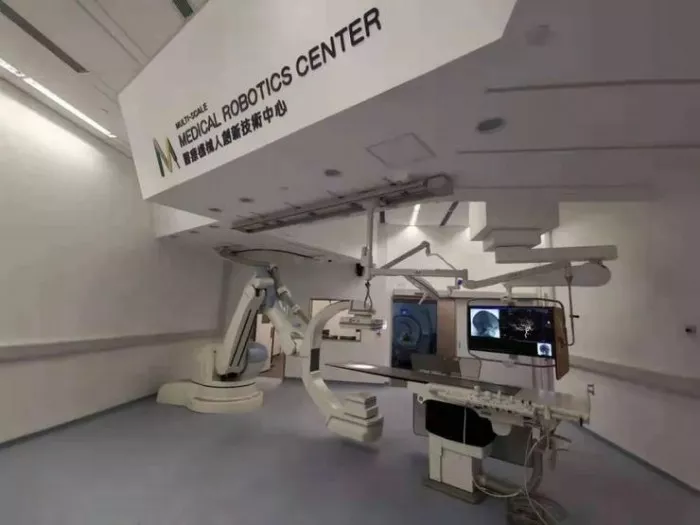
The picture is provided by Professor Zhang Li
"From the perspective of scientific research, I don't think the 'slim' robot is a landmark innovation." Zhang Li said, "what we hope to achieve is to endow micro robots with intelligence, make breakthroughs in the cluster and control system of micro robots, make devices safer, smaller and more intelligent, and then find its application export in medicine. The ultimate goal is to create happiness for mankind."
Perhaps, Feynman's idea of "in vivo surgeon" put forward in the 1950s will be realized in a short time. In the future, it can be applied to any part of the human body, such as fundus, retina, gastrointestinal tract, bladder or blood vessels.
Let's look forward to this day.